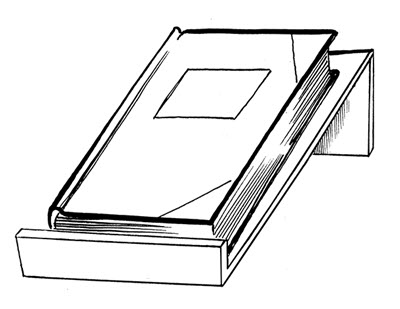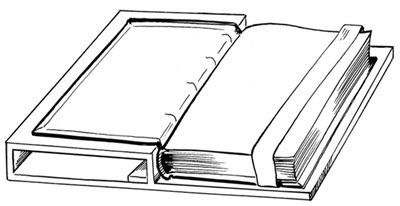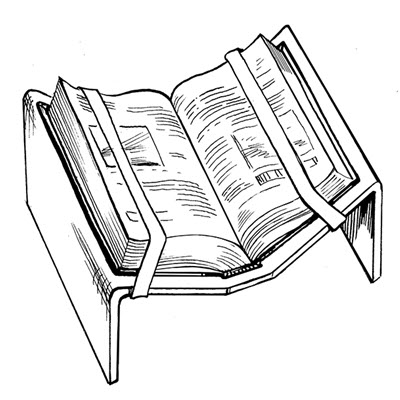Display Methods for Books – Canadian Conservation Institute (CCI) Notes 11/8
Disclaimer
The information in this document is based on the current understanding of the issues presented. It does not necessarily apply in all situations, nor do any represented activities ensure complete protection as described. Although reasonable efforts have been made to ensure that the information is accurate and up to date, the publisher, Canadian Conservation Institute (CCI), does not provide any guarantee with respect to this information, nor does it assume any liability for any loss, claim or demand arising directly or indirectly from any use of or reliance upon the information. CCI does not endorse or make any representations about any products, services or materials detailed in this document or on external websites referenced in this document; these products, services or materials are, therefore, used at your own risk.
Introduction
When displaying books, it is important to ensure adequate support. Almost all books are designed to be read. They are not static objects, and to prevent damage, accommodations must be made for the binding structure. Display aspects that will influence the final choice of how you support the book include the proposed environment, whether the book’s position will shift over the course of an exhibition, the book’s binding and the desired angle of display. This CCI Note was written to offer an introduction to book display methods and to provide references for further reading.
Support methods
Books require adequate support to prevent damage during handling or display. The methods used can be complex or improvised. A few simple and inexpensive display techniques can provide support for a book and help to prolong its life.
Materials
You can make a book mount using a variety of materials. These include the following:
- acid-free matboard (100% rag or highly purified wood pulp);
- acrylic sheet, such as Plexiglas;
- thermoplastic polymer sheet, such as Vivak;
- lightweight, inert plastic board, such as Coroplast (polypropylene twinwall plastic panel) or Hi-Core (polycarbonate twinwall profile sheet);
- archival corrugated board; and
- binder’s board covered in cloth or paper.
You may also purchase ready-made options from conservation suppliers or improvise using common materials. Examples include
- ready-made soft book pillows or beanbags;
- modular synthetic foam wedges;
- rolled textiles, such as a towel; and
- soft-covered weights.
Wood is not typically recommended as a material for displaying books in exhibitions. If this is unavoidable, you can seal the wood and face it with acid-free matboard to provide a buffer.
Book mounts
Mounts must always account for both the binding structure and the weight of the book. Do not display volumes upright with their covers open without proper support underneath the textblock, because the weight can distort and damage the binding structure. When displaying a book on an angle, ensure proper support along the thickness of the textblock by including a ledge or lip on the mount (Figure 1).

© Government of Canada, Canadian Conservation Institute. 131777-0001
Figure 1. A simple display stand for closed books with a ledge at the bottom to support the book.
Books opened to the title page, or to the first or last section of text, require support under the front or back cover to prevent the endpaper and binding material from splitting along the joint (Figure 2).

© Government of Canada, Canadian Conservation Institute. 131777-0002
Figure 2. Box mount supporting the front cover.
Polyethylene or polypropylene straps may be needed to support page openings. These are preferred over polyester terephthalate straps (Mylar-type), whose firmer edges may cut into the book materials. Be mindful of the physical limitations of the binding when applying strapping. Higher angles of display require significantly more support to prevent damage to the binding. Without support, gravity will pull on the binding and will likely cause significant damage to the sewing as well as the covering materials.
You can join the straps using a small piece of double-sided tape (3M #415), while taking care that the tape does not come into contact with the book. The straps should be wide enough for the size and thickness of the book and should not be fastened too tightly around the pages. You can also use small, lightweight rare-earth magnets covered in a protective material to hold pages open. However, if the magnets are too strong or left uncovered, they can cause damage to the textblock.
A book that is displayed fully open or that does not open easily due to the structural limitations of its binding requires a wide, V-shaped mount made of stronger, rigid materials like Plexiglas (acrylic plastic sheet), Vivak, metal, cloth-covered matboard or corrugated board (Figure 3). The vast majority of books do not open flat and will be damaged if forced into a 180-degree opening.
The angle of a V-shaped mount (or book cradle) should be customized to the desired opening for display.

© Government of Canada, Canadian Conservation Institute. 131777-0003
Figure 3. Example of a V-shaped book cradle for displaying an open book. Strapping holds the textblock on both sides of the cradle.
In the absence of a constructed V-shaped mount, you may use improvised or ready-made options to protect a book’s opening on display. Examples of these are listed in the Materials section. The most important aspect is to control the angle of opening so that the binding is supported.
Display conditions
Ideally, books should be displayed in a specially constructed display case that protects them from dust and from extreme fluctuations in temperature and relative humidity (RH). Do not display volumes near a heat source, such as a hot air vent, or in direct incandescent or natural light.
Do not display books with sensitive images (such as those containing inks, watercolours or coloured pencil) in direct light. The colourants are extremely sensitive to light, and permanent display under high light levels will cause the ink and pigments to fade or darken. To control the amount of light to which books are exposed, keep display lights on only when required and set the lights to the lowest intensity possible.
If a volume is to be displayed for long periods of time, it is beneficial to consider displaying more than one opening in the book to limit exposure and damage. Wood pulp papers may contain lignin that will also darken with light exposure. Depending on the book, you may require multiple book cradles to support multiple page openings.
Books bound in parchment or books with a parchment textblock will require time to return to a closed position if they are kept open for any length of time. They are much more susceptible to a change and fluctuations in RH and are prone to physical distortion. They can be damaged if forced closed after a lengthy exhibition.
Conclusion
Books require support that accommodates their physical characteristics and limitations. A thoughtful approach to supporting a bound volume on display will help to preserve it. For a general overview of mount-making, consult Mount-making for Museum Objects. Other sources listed in the Further reading section describe alternate options for the display of books.
Suppliers
- Carr McLean (Canada)
- George Hill & Co. (Canada)
- Talas (USA)
- University Products (USA)
- Conservation by Design (UK)
Further reading
AIC Wiki. Exhibition Standards & Guidelines, 2020.
Baier, R. “Vivak: An Alternative to Conventional Plexiglas and Museum Board for Exhibition Mounts.” The Book and Paper Group Annual 22 (2003), pp. 109–110.
Balloffet, N., and J. Hille. “Section 6: Small Exhibitions.” In Preservation and Conservation for Libraries and Archives. Chicago, IL: American Library Association, 2004.
Barclay, R.L., A. Bergeron and C. Dignard. Mount-making for Museum Objects, 2nd ed. Illustrated by C. Schlichting. Ottawa, ON: Canadian Conservation Institute, 2002.
Bibliothèque et Archives nationales du Québec. Une technique utile : l’exposition des livres (in French only). Montréal, Quebec: Bibliothèque et Archives nationales du Québec, n.d.
Blaser, L. “Display Cradles for Books: Board Construction” (PDF format). Guild of Book Workers Journal 30,1 (Spring 1992), pp. 1–16.
Blaser, L. “Construction of Plexiglas Book Cradles.” The Book and Paper Group Annual 15 (1996), pp. 3–23.
Book and Paper Group Wiki. Exhibition, Supports, and Transport, 2022.
Canadian Conservation Institute. Making Enclosures for Books and Paper Objects. CCI Notes 11/1. Ottawa, ON: Canadian Conservation Institute, 1996.
Clarkson, C. “The Safe Handling and Display of Medieval Manuscripts and Early Printed Books.” The New Bookbinder 19 (1999), pp. 12–38.
Glaser, M.T., B. Caswell-Olson, S. Gramly and A.M. Willer. Protecting Paper and Book Collections During Exhibition, revised. Preservation Leaflet 2.5. Andover, MA: Northeast Document Conservation Centre, 2020.
Grattan, D., and S. Michalski. Environmental guidelines for museums. Ottawa, ON: Canadian Conservation Institute, 2017.
Hannington, D., and C. McNair. Basic Care of Books, revised. CCI Notes 11/7. Ottawa, ON: Canadian Conservation Institute, 2022.
Hovey, D. “Short Communication: Simple and Invisible Solutions Using Rare Earth Disc Magnets in Mountmaking” (PDF format). Journal of the American Institute for Conservation 51,1 (Spring/Summer 2012), pp. 51–58.
Mesmer, R. “Tips: Materials and Techniques for Mounts, Encapsulations, and Book Supports.” The Book and Paper Group Annual 32 (2013), pp. 84–87.
Michalski, S., and J. Druzik. LED Lighting in Museums and Art Galleries. Technical Bulletin 36. Ottawa, ON: Canadian Conservation Institute, 2020.
Tétreault, J. Coatings for Display and Storage in Museums. Technical Bulletin 21. Ottawa, ON: Canadian Conservation Institute, 1999.
Various. Don’t Rock the Cradle Symposium. Washington, D.C.: Folger Shakespeare Library, 2015.
Williams, R. “Adaptable Conservation Book Support (ACBS).” [YouTube video]. London, UK: The Institute of Conservation, Book and Paper Group, 2020.
By David Hannington
Revised by Christine McNair in 2022
Originally published in 1994
© Government of Canada, Canadian Conservation Institute, 2022
Cat. No.: NM95-57/11-8-2022E-PDF
ISSN 1928-1455
ISBN 978-0-660-46184-7